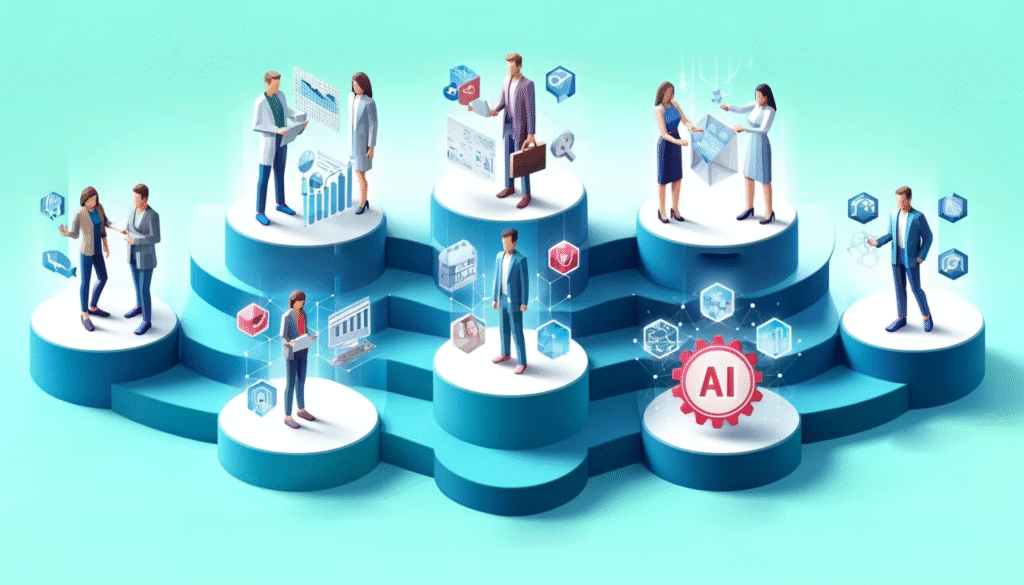
For decades, marketing and sales have been two sides of the same coin—each responsible for driving growth, but often working in conflicting directions.
Marketing’s mission: Generate leads and brand awareness.
Sales’ mission: Close deals and drive revenue.
Despite sharing the same end goal, these teams frequently clash over:
- What defines a qualified lead
- Who owns the buyer journey
- How success should be measured
- What tools and data should be trusted
This misalignment drains resources, creates friction, and stifles growth.
But what if Artificial Intelligence could finally change that?
1. The Root of Misalignment
Marketing and sales misalignment stems from four core issues:
🔹 Different KPIs
Marketing often focuses on MQLs, web traffic, and engagement.
Sales focuses on quotas, opportunities, and pipeline velocity.
🔹 Siloed Data & Systems
Each team uses different tools—CRMs, marketing automation, spreadsheets—resulting in fragmented customer views.
🔹 Poor Lead Handoff
Marketing passes leads to sales too early (or too late), causing reps to dismiss MQLs as “junk.”
🔹 No Shared Visibility
Without a unified dashboard or workflow, teams lack real-time alignment around what’s working.
2. Enter AI: The Real-Time Revenue Ally
AI has emerged not as a new tool—but as an intelligent layer that connects systems, interprets data, and guides action.
✅ Shared Buyer Intelligence
AI collects and interprets data across platforms—email, CRM, web behavior, chat, ads—creating a 360-degree buyer profile that both teams can rely on.
- Understand where leads are in their journey
- Identify what content or actions trigger conversion
- Align messaging across all touchpoints
✅ Predictive Lead Scoring & Prioritization
Instead of relying on arbitrary lead scores, AI uses historical conversion data and real-time behaviors to predict which accounts are likely to convert—and when.
- Sales gets warm, high-quality leads
- Marketing focuses on nurturing the right segments
✅ Revenue Attribution That Both Teams Trust
AI connects marketing campaigns to closed deals, helping answer the age-old question: “Which effort actually drove revenue?”
- No more attribution debates
- Investment decisions based on real outcomes
✅ Adaptive Engagement
AI recommends next-best actions for marketing automation or sales outreach based on engagement signals.
- Personalized touchpoints, better timing
- Seamless transitions between marketing nurture and sales conversations
3. When Goals Align, Results Follow
With AI as the backbone of your revenue strategy, teams can align around mutual KPIs, such as:
- Pipeline contribution by campaign or channel
- Account engagement and readiness
- Lead-to-opportunity conversion rates
- Deal acceleration and forecast accuracy
And when marketing and sales goals align, the payoff is massive:
| Metric | Improvement |
|---|---|
| Lead Conversion Rate | +30–50% |
| Campaign ROI | +2–3x |
| Sales Cycle Time | -20–40% |
| Win Rate | +38% |
(Source: Forrester, Gartner, HubSpot AI Trends 2025)
4. Real-World Use Case: From Leads to Revenue
Let’s say:
- AI identifies a cluster of mid-market accounts browsing pricing pages.
- Marketing launches a hyper-personalized email and ad sequence.
- A sales rep is notified with intent data and talking points tailored to that vertical.
- AI updates the CRM in real-time with engagement scores and likelihood to close.
The result?
Aligned action. Shorter sales cycles. More wins.
5. Expert Insight
“AI doesn’t just help you do marketing and sales better—it helps you do them together,”
says Shane Liu, Chief Revenue Officer at RevSync AI.
“We’re no longer arguing over attribution. We’re planning campaigns based on unified goals, shared data, and intelligent insights.”
6. Challenges to Adoption—and How to Overcome Them
Despite the promise, AI adoption often faces organizational hurdles:
- Change resistance from sales teams wary of automation
- Data quality issues that reduce AI effectiveness
- Skepticism around “black box” predictions
Solution: Start small.
Pilot AI for lead scoring, engagement alerts, or revenue forecasting. Build trust through visible results, and expand from there.
7. Conclusion: Yes—AI Can Unite Sales and Marketing
AI can’t replace strategy, communication, or collaboration—but it removes ambiguity, surfaces actionable insights, and aligns teams around the same truths and targets.
It’s not just about better tools. It’s about building a shared revenue engine powered by intelligent, real-time data.
AI is not just a bridge—it’s the foundation.